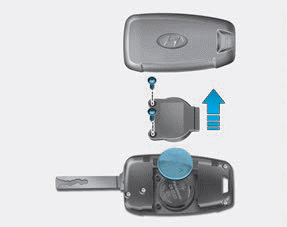Hyundai Palisade: Rear Glass Defogger / Rear Glass Defogger Printed Heater
Hyundai Palisade (LX2) 2020-2025 Service Manual / Body Electrical System / Rear Glass Defogger / Rear Glass Defogger Printed Heater
Repair procedures
| Inspection |
Wrap tin foil around the end of the voltmeter test lead to prevent damaging
the heater line. Apply finger pressure on the tin foil, moving the tin
foil along the grid line to check for open circuits.
|

| 1. |
Turn on the defogger switch and use a voltmeter to measure the voltage
of each heater line at the glass center point. If a voltage of approximately
6V is indicated by the voltmeter, the heater line of the rear window
is considered satisfactory.
|
| 2. |
If a heater line is burned out between the center point and (+) terminal,
the voltmeter will indicate 12V.
|
| 3. |
If a heater line is burned out between the center point and (-) terminal,
the voltmeter will indicate 0V.
|
| 4. |
To check for open circuits, slowly move the test lead in the direction
that the open circuit seems to exist. Try to find a point where a voltage
is generated or changes to 0V. The point where the voltage has changed
is the open-circuit point.
|
| 5. |
Use an ohmmeter to measure the resistance of each heater line between
a terminal and the center of a grid line, and between the same terminal
and the center of one adjacent heater line. The section with a broken
heater line will have a resistance twice that in other sections. In
the affected section, move the test lead to a position where the resistance
sharply changes.
|
Repair Of Broken Heater Line
Prepare the following items :
| 1. |
Conductive paint.
|
| 2. |
Paint thinner.
|
| 3. |
Masking tape.
|
| 4. |
Silicone remover.
|
| 5. |
Using a thin brush :
Wipe the glass adjacent to the broken heater line, clean with silicone
remover and attach the masking tape as shown. Shake the conductive paint
container well, and apply three coats with a brush at intervals of about
15 minutes apart. Remove the tape and allow sufficient time for drying
before applying power. For a better finish, scrape away excess deposits
with a knife after the paint has completely dried. (Allow 24 hours).
|
 Components and components location
Components and components location
Component Location
1. Rear glass defogger relay
(Buil-in engine room relay box)
2. Rear glass defogger switch (Dual type)
3...
 Rear Glass Defogger Switch
Rear Glass Defogger Switch
Repair procedures
Diagnosis with Diagnostic
tool
Diagnosis with Diagnostic tool
1.
In the body electrical system, failure can be quickly diagnosed by using
the vehicle diagnostic system (Diagnostic tool)...
Other information:
Hyundai Palisade (LX2) 2020-2025 Owner's Manual: Child-Protector Rear Door Locks
The child safety lock is provided to help prevent children seated in the rear from accidentally opening the rear doors. The rear door safety locks should be used whenever children are in the vehicle. The child safety lock is located on the edge of each rear door...
Hyundai Palisade (LX2) 2020-2025 Owner's Manual: Instrument panel vents, Temperature control
Instrument panel vents The instrument panel vent air flow can be directed up/down or left/right using the vent adjustment lever. The outlet vents can be opened or closed separately using the vent control lever. If you move the vent control lever to the left end, the outlet vents can be closed...
Categories
- Manuals Home
- 1st Generation Palisade Owners Manual
- 1st Generation Palisade Service Manual
- Check Tire Pressure
- AC Inverter
- Automatic Door Lock and Unlock Features
- New on site
- Most important about car
Battery replacement

If the remote key is not working properly, try replacing the battery with a new one.
Battery Type: CR2032
To replace the battery:
Copyright © 2025 www.hpalisadelx.com







